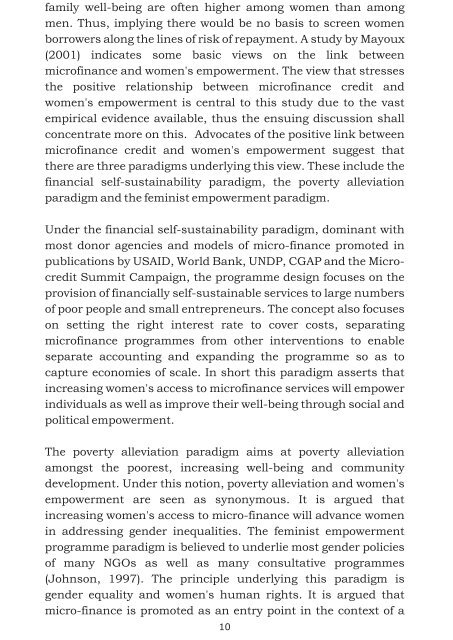Beneficiaries are actors too.pdf - Southern Institute of Peace ...
Beneficiaries are actors too.pdf - Southern Institute of Peace ...
Beneficiaries are actors too.pdf - Southern Institute of Peace ...
You also want an ePaper? Increase the reach of your titles
YUMPU automatically turns print PDFs into web optimized ePapers that Google loves.
family well-being <strong>are</strong> <strong>of</strong>ten higher among women than among<br />
men. Thus, implying there would be no basis to screen women<br />
borrowers along the lines <strong>of</strong> risk <strong>of</strong> repayment. A study by Mayoux<br />
(2001) indicates some basic views on the link between<br />
micr<strong>of</strong>inance and women's empowerment. The view that stresses<br />
the positive relationship between micr<strong>of</strong>inance credit and<br />
women's empowerment is central to this study due to the vast<br />
empirical evidence available, thus the ensuing discussion shall<br />
concentrate more on this. Advocates <strong>of</strong> the positive link between<br />
micr<strong>of</strong>inance credit and women's empowerment suggest that<br />
there <strong>are</strong> three paradigms underlying this view. These include the<br />
financial self-sustainability paradigm, the poverty alleviation<br />
paradigm and the feminist empowerment paradigm.<br />
Under the financial self-sustainability paradigm, dominant with<br />
most donor agencies and models <strong>of</strong> micro-finance promoted in<br />
publications by USAID, World Bank, UNDP, CGAP and the Microcredit<br />
Summit Campaign, the programme design focuses on the<br />
provision <strong>of</strong> financially self-sustainable services to large numbers<br />
<strong>of</strong> poor people and small entrepreneurs. The concept also focuses<br />
on setting the right interest rate to cover costs, separating<br />
micr<strong>of</strong>inance programmes from other interventions to enable<br />
separate accounting and expanding the programme so as to<br />
capture economies <strong>of</strong> scale. In short this paradigm asserts that<br />
increasing women's access to micr<strong>of</strong>inance services will empower<br />
individuals as well as improve their well-being through social and<br />
political empowerment.<br />
The poverty alleviation paradigm aims at poverty alleviation<br />
amongst the poorest, increasing well-being and community<br />
development. Under this notion, poverty alleviation and women's<br />
empowerment <strong>are</strong> seen as synonymous. It is argued that<br />
increasing women's access to micro-finance will advance women<br />
in addressing gender inequalities. The feminist empowerment<br />
programme paradigm is believed to underlie most gender policies<br />
<strong>of</strong> many NGOs as well as many consultative programmes<br />
(Johnson, 1997). The principle underlying this paradigm is<br />
gender equality and women's human rights. It is argued that<br />
micro-finance is promoted as an entry point in the context <strong>of</strong> a<br />
10


